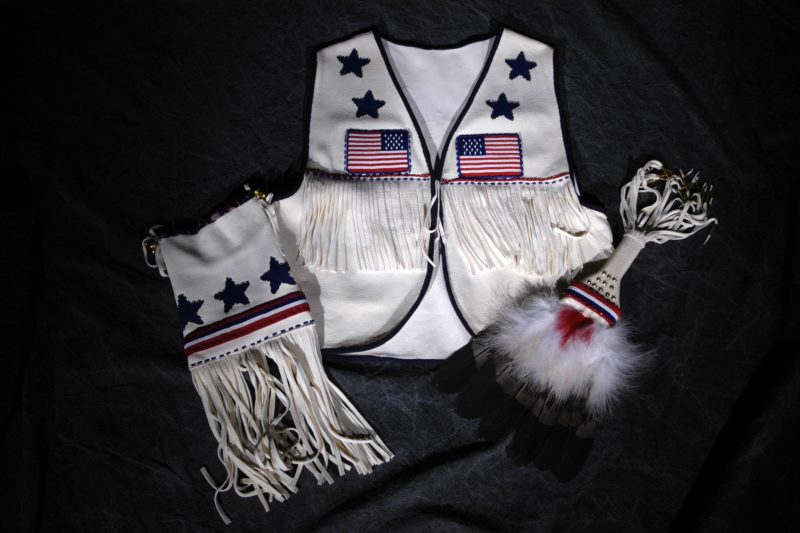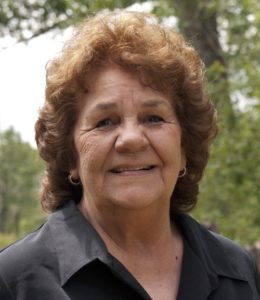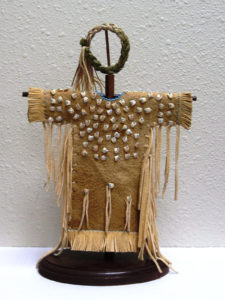
Beaded flag vest trio by Jackie Parsons, who "has woven her artistry into her daily life and in teaching future generations of artists.”
Blackfeet traditional artist Jackie Parsons was among the six 2018 Governor’s Arts Award honorees honored during a public ceremony Dec. 7 at the Capitol Rotunda in Helena. The Montana Arts Council hosted the ceremony and a reception that followed for Parsons and fellow honorees Rick Bass, Monte Dolack, Jaune Quick-to-See Smith, Kevin Red Star and Annick Smith.
The Governor’s Arts Award recognizes outstanding individuals and organizations whose achievements in the arts, or on behalf of the arts, benefit all Montanans. The six honorees were nominated by the public and reviewed by the Montana Arts Council’s Governor’s Arts Awards Committee before being presented to, and approved by, the Gov. Steve Bullock.
The 2018 recipients join the ranks of more than 100 Montanans honored since the awards were established in 1981, including Rudy Autio, James Lee Burke, Judith Blegen, Agnes Oshanee Kenmille, Wally McRae, Frances Senska, Michael Smuin and Benjamin Steele, to name just a few.

When I’m wearing a Blackfeet dress that I have made, I feel really powerful, because I feel so very connected to everything around me.
– Jackie Parsons (Eck Skim Aue Kee), Traditional Artist
Arlynn Fishbaugh, retired executive director of the Montana Arts Council, worked with Jackie Parsons for more than 20 years – many of those while Parsons served as chair of the Montana Arts Council. She nominated the Blackfeet artist for the Governor’s Arts Award in part, she says, because of “the way she has woven her artistry into her daily life and in teaching future generations of artists.”
“It was from Jackie that I learned that in the Blackfeet language – as in many other native languages – there is no word for art. That is because art is so fully integrated into daily life that no word is necessary to define it.”
Parsons’s Blackfeet name, Eck Skim Aue Kee, means “Woman of Iron.” The strength embodied by her name manifests in her art, her teaching and her commitment to her community.
Parsons: “Respected and celebrated nationally”
She was a featured artist and helped curate “Identity by Design: Tradition, Change, and Celebration in Native Women’s Dresses,” the inaugural exhibit at the Smithsonian’s National Museum of the American Indian in Washington, D.C., which then toured to the museum’s New York City branch at the George Gustav Heye Center. Her work was also prominently featured in the coffee-table book that accompanied the exhibition.
Of her own dressmaking, Parsons said, “When I’m wearing a Blackfeet dress that I have made, I feel really powerful, because I feel so very connected to everything around me.”
She was also selected by the Smithsonian as co-curator of Blackfeet Nation, a 30-piece display that was part of the rotating tribal community exhibition, “Our Peoples: Giving Voice to Our Histories.”
“It’s really been a spiritual encounter for me to be able to let the general public know what we are all about, that we are not savages, that we have a high intelligence of life and know how to utilize our natural surroundings,” she said of that curatorial experience.
The First People’s Fund, a national organization serving Native American artists, also recognized Parsons’s artistic excellence through its 2008 Cultural Capital Fellowship and its 2012 Community Spirit Award that “honors and celebrates exceptional Native artists and culture bearers across the country.”
Fishbaugh, who attended the Community Spirit Award ceremony, wrote that the celebration “left an indelible mark on my understanding of just how much Jackie’s artistry is respected and celebrated nationally.”
Family taught, inspired young artist

Parsons was born and raised on the Blackfeet Indian Reservation. Orphaned at age 3, she spent the next seven years under the care of her grandmother, a self-taught seamstress who demonstrated the rudiments of sewing to Parsons at a young age. Upon her grandmother’s death, her aunt and uncle raised her, and along with other relatives, they inspired her creativity through their own artistic endeavors.
1n 1955, she married rancher Ken Parsons and they had six children – all are artists, and four are pursuing professional careers in the arts.
In 1996, Parsons was prompted to enter a competitive art show in Great Falls, and won Best of Show with her traditional woman’s saddle. Later that year, she was juried into the Northern Plains Tribal Arts Show in Sioux Falls, SD. Her art is now in permanent collections in New Zealand and China, and is represented by galleries across the United States.
Over the years Parsons has expressed herself in several mediums, most notably quillwork, beadwork and clothing design, but also woodcarving, painting, silversmithing and writing. She continues to collaborate with other Native American artists, including her own children and Blackfeet beadworker Ladean Miller.
Parsons is among the longest-serving council members of MAC (1994-2013); she was appointed chairman by Gov. Brian Schweitzer in 2005 and held that post until retiring from the council in 2013.
Larry Williams, executive director of MAC when Parsons was first appointed to the council, describes her as “an enormously gifted human with a strength of character and wisdom that is very quickly recognized by others. She is also an exceptional and consummate artist … She remains an engaged, clear and concise spokesperson for the arts and creative process.”
For Parsons, art is a continuum
Indeed, art has been a continuum through her life. She promoted arts and crafts in her region for 35 years as the director of the Northern Plains Craft Association, and is currently at work on a book titled Teaching Art to Young People.
For over a decade she also mentored up to 10 students for the annual art show at the Heard Museum in Phoenix, AZ. Her students were national award-winners every year, competing among more than 1,300 students.
Her community dedication has taken her to other arenas as well. Over the years, she worked as tribal secretary, a nutrition technician, home economist specialist, prosecutor, Blackfeet tribal judge and author. She taught at the local community college and served as a Blackfeet Appellate Court Justice and on the Blackfeet Tribal Election Board.
“Many young people now speak our language, participate in powwows, practice our traditional religion, and use their natural artistic talent to keep our tradition alive,” said Parsons. “It has been and continues to be, my pleasure and privilege to have the honor of passing on our traditions visually, verbally and through teaching.”
– Kristi Niemeyer